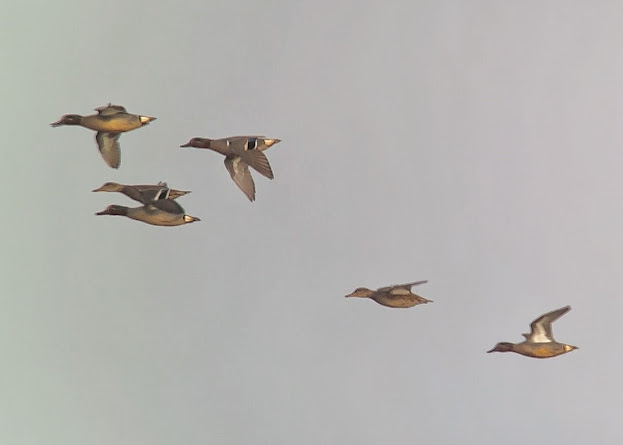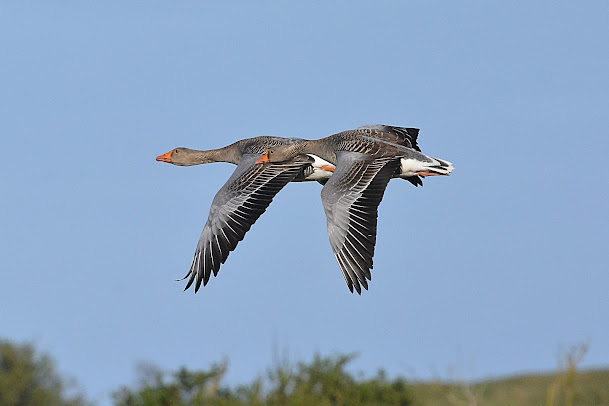April 26th. Still cold with a fairly brisk northerly wind, mostly overcast with some early rain showers. Birds around included a Brambling, 6 Pintail, 2 Med Gulls and a Cuckoo.
April 25th. Fairly cold start, with moderate south-westerly wind, and with some light rain in late morning. Pretty quiet at sea although a male Velvet Scoter went south close in. Otherwise, just a few Common Scoter parties, 7 Red-breasted Merganser and a Fulmar north. Unusually, another Fulmar was seen over the West Dunes! Other birds around included a Great White Egret, a Grey Heron and a Barn Owl. A Green-winged Teal was anew arrival on the Freshwater Marsh and a Whooper Swan was on Croftmarsh. After recent flooding there is plenty of Snipe habitat on site and a single Jack Snipe was with several Common Snipe.
A morning ringing session in East Dunes provided a new Lesser Whitethroat; and a retrap Willow Warbler.
April 24th. Increasing north-westerly wind, with occasional brief light rain in morning. Another fairly quiet day with highlights of Great White Egret, Peregrine, Cuckoo and 2 Wheatears.
A weather-restricted morning ringing session in East Dunes produced 11 new birds: 5 Willow Warbler, a Chiffchaff, 4 Blackcap and a Tree Pipit; and 5 retraps: 2 Blue Tit, 2 Chiffchaff and a Dunnock.
April 23rd. North-westerly breeze, dry initially with ran shower later followed by drizzle.
500 Common Scoter were seen at the mouth of the Wash early on and were joined by a Velvet Scoter from the north in a brief sea-watch when 8 Arctic Tern and 15 Sandwich Tern flew north and 2 Little Terns were blogging. Black-tailed Godwit increased to 70 with a Spoonbill on Tennyson's Sands. Other birds around included Whimbrel, Marsh Harrier and Merlin.
April 22nd. Less cold that recent mornings but still a cool westerly breeze. Again, lots of birdsong from the dune scrub, including a few Willow Warblers, Sedge Warblers and a Reed Warbler along with at least one Cuckoo. An Osprey passed over west early afternoon. On the beach a mass of feeding Gulls attracted by the recent wash-out of razor shells etc. At least 1500 Herring Gulls were present, although the only rare gull of the day was a Caspian Gull found on Tennyson's Sands. A build up of Common Scoter was apparent at the mouth of the Wash with a raft of 450 on the sea and another 800 moving north. A ringtail Hen Harrier and a Jay went south.
A morning ringing session in East Dunes resulted in 18 new birds: a Chiffchaff, 3 Willow Warbler, 2 Blackcap, a Chaffinch, 3 Blue Tit, 2 Linnet, 4 Reed Bunting, a Wheatear and a Dunnock; and 6 retraps: a Wren, a Blue Tit, a Dunnock, a Linnet, a Chaffinch and a Great Tit.
 |
| Wheatear, ringed 22 April 2024. Photo - George Gregory |
April 21st. A chilly start and little significant change in bird numbers or movements. A Cuckoo was vocal on the west side with up to 4 Grasshopper Warblers till reeling.
A morning ringing session in East Dunes provided 8 new birds: a Chiffchaff, 2 Blackcap, a Chaffinch, 2 Blue Tit, a Cetti's Warbler and a Dunnock; and 2 retraps: a Dunnock and a Wren.
Following the steady colonisation of the Reserve by Cetti's Warblers, some four or five territories were established in 2022, but since that time, they have become very hard to find. Two out of three recent records relate to birds trapped during ringing sessions at different sites and no song heard this spring.























































%20Sam%20Goddard.jpg)








